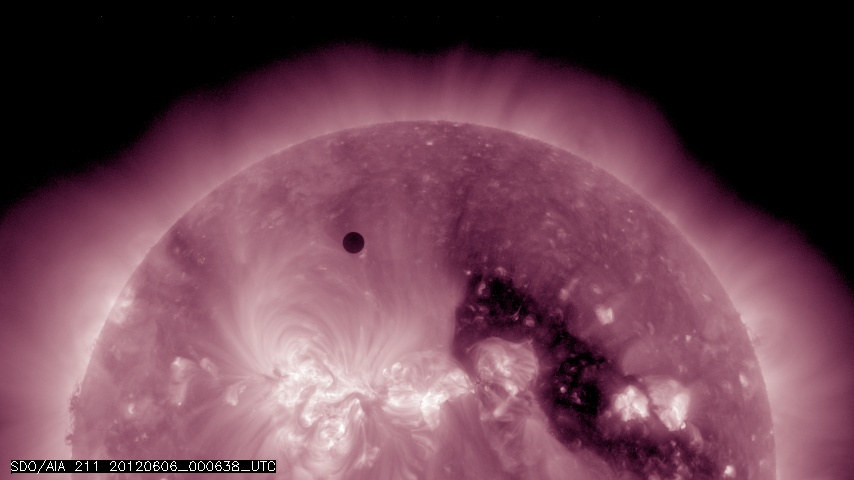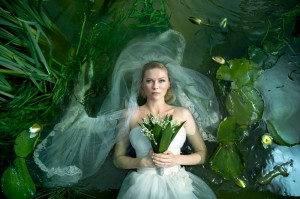Venus/Melancholia
by wjw on June 6, 2012
 I spent much of the afternoon and early evening shuttling in and out of the house watching the Transit of Venus. Through the telescope the sun seemed quiescent and slightly blotchy, and then a black disk began to move across it, as if our star had donned a beauty patch. Venus was larger than I anticipated— I had expected a point, but I could see an actual disk.
I spent much of the afternoon and early evening shuttling in and out of the house watching the Transit of Venus. Through the telescope the sun seemed quiescent and slightly blotchy, and then a black disk began to move across it, as if our star had donned a beauty patch. Venus was larger than I anticipated— I had expected a point, but I could see an actual disk.
I took numerous pictures, but my zoom lens, as it turns out, couldn’t reach all the way to Venus. The sun’s disk, and the little mark on it, ended up looking like a blocky computer graphic from the days when 48K was all we could expect by way of RAM.
So here’s a NASA photograph instead. We could call it Our Scary Sun.
Since the day was occupied with a rare astronomical event, I think it’s reasonable to relay my impressions of a film having to do with another astronomical event altogether.
 Which is to say, the end of the world.
Which is to say, the end of the world.
Which is to say Melancholia, a sort of science fiction film by the ever-inventive Lars von Trier.
The film opens with a jaw-dropping series of beautiful surrealistic images that go on for a full eight minutes (I counted). To the orchestral booming of Wagner’s Tristan und Isolde, we see Kirsten Dunst floating like Ophelia in her wedding dress, or standing motionless on a lawn while dead birds rain down around her, or watching lightning shoot from her fingers, or planets colliding or exploding . . .
The beautiful images don’t go away once the story actually starts. This is one of the most visually impressive movies I’ve seen in ages, and cinematographer Manuel Alberto Claro ought to have his eyeballs cast in bronze, or something. (After which the eyeballs could be pierced with an icepick, in revenge for the film’s shaky-cam.)
We open with Justine (Dunst) and new husband Michael (Alexander Skarsgard) on their way to their wedding reception in a stretch limo. Unfortunately the limousine is too stretched to actually negotiate the twisty rural roads leading to their destination, and so the pair arrive on foot hours late. Hosting the couple is Justine’s sister Claire (Charlotte Gainsborough) and her annoying rich husband John (Kiefer Sutherland), who owns the Danish castle where the reception is taking place. The rituals of a full-blown fancy wedding reception drag on and on, and include Justine’s long-separated parents (John Hurt and Charlotte Rampling) deciding the wedding is really all about them and making a scene. All this turns out to be far too much for Justine, who wanders off to take a nap, then a bath, after which she insults her asshole boss and gets fired, after which she has meaningless sex with a stranger. When the husband leaves, he leaves alone.
Some time later, Justine returns to the castle in a state of depression so profound that she can’t even bathe herself, and we first see the expression of mute, unending psychic pain that occupies Ms Dunst’s face for most of the rest of the movie. (I suspect it is not a coincidence that she’s named after one of de Sade’s heroines, who exists only to be tortured.) While Justine more or less literally becomes the ghost at the feast, we find that Earth is menaced by a giant blue planet called Melancholia, which may (according to Claire) or may not (according to John) collide with the Earth.
I get the metaphor: having someone in the family afflicted with mental illness is akin to having your whole world run over by a giant blue planet. Or maybe your eyeballs run over by the movie’s jerky-cam. (When the image isn’t stationary and beautiful, it’s palsied.) But beyond the metaphor, beyond the constant romantic strains of Wagner, beyond the brilliant cinematography . . . is there anything actually there?
No. There is no there here. Which is part of von Trier’s point, but once he’s made it, he enjoys making it over and over again.
I understand why you might want to do a small story about the end of the world as viewed through a small family, but did it really have to be this family? One is paralyzed with clinical depression, one is anxious, one is annoying, and one (the son, who I haven’t mentioned) is just not a very interesting kid.
(None of them survive, by the way. Nor does the world. Bruce Willis and Morgan Freeman do not show up to save the day. Melancholia totally roasts our asses. Not like I’m into spoilers or anything.)
The movie is very long, well over two hours. I found myself fast-forwarding through it in hopes of finding some interesting character interaction. There wasn’t much. No one in the film had enough energy to even achieve desperation.
It’s a beautiful movie in which the action is fairly random and in which everyone dies. This is not an unsupportable description of reality, but if it’s your reality, then you’re already there. If you know what I mean.
But Venus and the Sun. Wow. Beautiful. And we all survived an’ everything.
Previous post: Dead Soldiers
Next post: Teh Science
 I spent much of the afternoon and early evening shuttling in and out of the house watching the Transit of Venus. Through the telescope the sun seemed quiescent and slightly blotchy, and then a black disk began to move across it, as if our star had donned a beauty patch. Venus was larger than I anticipated— I had expected a point, but I could see an actual disk.
I spent much of the afternoon and early evening shuttling in and out of the house watching the Transit of Venus. Through the telescope the sun seemed quiescent and slightly blotchy, and then a black disk began to move across it, as if our star had donned a beauty patch. Venus was larger than I anticipated— I had expected a point, but I could see an actual disk. Which is to say, the end of the world.
Which is to say, the end of the world.
You had the answer since the beginning. Venus is made of the same stuff of Earth, likely Venus gave birth to earth. Venus is associated with Lucifer meaning light bearer, sun of the morning like Venus. I never saw Melancholia (will see in the next days), just saw the Intro with the objective music of Tristan and Isolda, a Wagner piece inspired by Dali’s Dream of Venus.
sorry about the silly and wrong Dali´s reference. Dali worked on a ballet called Dream of Venus” using the Venusberg Bacchanale from the first act of Wagner’s Tannhäuser
Comments on this entry are closed.